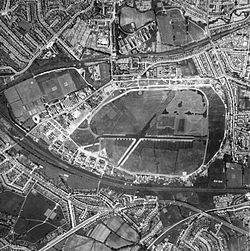RAF Hendon
| Hendon Aerodrome | |
|---|---|
| Hendon, north London | |

Aerial view circa 1941-1942
|
|
| Coordinates | 51°36′00″N 0°14′46″W / 51.600°N 0.246°W |
| Type |
Naval air station Royal Air Force station |
| Site information | |
| Owner |
Air Ministry (1922-1964) Ministry of Defence |
| Controlled by |
Grahame-White Aviation Co. |
| Site history | |
| In use | c.1908-1987 |
| Battles/wars |
First World War Second World War |
Hendon Aerodrome was an aerodrome in London, England, that was an important centre for aviation from 1908 to 1968.
It was situated in Colindale, seven miles (11.3 km) north west of Charing Cross. It nearly became "the Charing Cross of the UK's international air routes", but for the actions of the RAF after the First World War. It was known as a place of pioneering experiments including the first airmail, the first parachute descent from a powered aircraft, the first night flights, and the first aerial defence of a city.
Henry Coxwell and James Glaisher were the first to fly from Hendon in a balloon called the Mammoth in 1862; and ballooning at the Brent Reservoir was a very popular spectacle for the crowds gathered on bank holidays late in the 19th century. The first powered flight from Hendon was in an 88-foot (27 m) long non-rigid airship built by Spencer Brothers of Highbury. It took off from the Welsh Harp Reservoir in 1909, piloted by Henry Spencer, and the only passenger was Muriel Matters, the Australian suffragette. The first attempt at heavier-than-air flight was by H.P. Martin and G.H. Handasyde, again at the Welsh Harp. They constructed a monoplane with four engines in the ballroom of the hotel, but were never able to get airborne.
Inspired by Louis Blériot’s flight across the Channel, Everett, Edgecumbe and Co began to experiment with an aircraft to be built at their works at Colindale near Hendon, erecting a small hangar to house it. From 1908 to 1910, their "Grasshopper", as the plane was called, taxied about and left the ground briefly, but failed to get truly airborne, although these attempts attracting quite a crowd.
In 1906, before any powered flight had taken place in Britain, the Daily Mail newspaper had challenged aviators to fly from London to Manchester or vice versa, offering a prize of £10,000. The journey had to be completed within twenty-four hours, with no more than two landings. Aircraft and engine design had improved sufficiently by 1910 to make an attempt to win the prize realistic, and both Claude Grahame-White and the French aviator Louis Paulhan prepared for the challenge during April 1910. Grahame-White made two attempts, but it was Paulhan who succeeded. He chose a field on the future aerodrome site as his point of departure. On 27 April he flew 117 miles (188 km) from Hendon to Lichfield, easily the longest flight accomplished in the UK at that time. Before dawn on 28 April he took off and reached Burnage on the outskirts of Manchester after three hours 55 minutes in the air, during a period of just over twelve hours. This was the first true flight from the Hendon site.
...
Wikipedia
